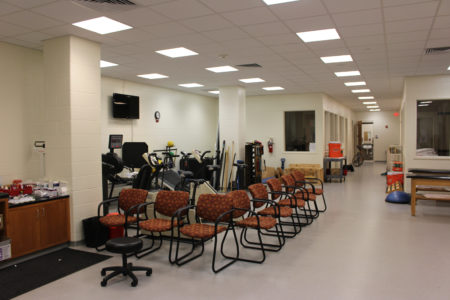In the last few years, Anterior Cruciate Ligament (ACL) tears at Grinnell College have been on the rise. Currently, more than eight women have suffered a torn ACL while playing for Grinnell sports teams, spread between the basketball, soccer and volleyball teams.
The ACL is located on the outer half of each knee and is responsible for holding together the knee with the help of three other ligaments, primarily with side-to-side motions.
“The injury itself was super weird,” said Juliet Torres ’19, a member of the women’s soccer team who suffered an ACL tear less than four weeks ago. “A few days after [the tear] I was able to get up and walk. I could do most things pretty normally going forward, my knee just wouldn’t be able to do anything going side-to-side.”
An ACL tear usually results from torque on the knee that overwhelms the ligament, commonly due to the knee over-rotating inward. However, the majority of ACL injuries are categorized as non-contact injuries.

“It wasn’t anything seemingly dangerous,” said Haley Reynolds ’21, also a member of the women’s soccer team, who tore her ACL in late August. “I just went in for a tackle as normal and just heard a pop. That was it.”
ACL injuries occur at an elevated rate for women. Jason Kofoot, the primary athletic trainer for the women’s soccer team, has worked with the four athletes with ACL tears this year.
“[Women’s] hips are wider so they have a larger angle at the knee, this puts them at a disadvantage for a lot of these knee injuries,” said Kofoot.
Additionally, the angle of many women’s knees place them at a higher risk of injury.
“[Women] also have a slightly different knee joint then men and, generally, the muscles don’t support as much weight,” said Kofoot. “For the women’s soccer program here we’ve begun to work prevention into our program.”
In addition to adding new stretches to warm-ups, Kofoot has noticed a trend towards prevention even before athletes arrive at the College.
“A lot of the stuff that has been going on is in high school,” Kofoot said. “[The stretches] strengthen the musculature around the hip joint and the knee, along with teaching correct positioning.”
Surgery is the most common solution for ACL injuries, both at Grinnell and in the U.S.. ACL reconstruction surgery usually involves removing the torn ligament and taking a ligament from the patella (the ligament that connects the kneecap to the tibia), or two tendons from the hamstring. While, surgery is the most effective way to recover, it is also a difficult process that takes nearly eight to ten months of recovery time until full athletic participation is possible.
“It takes so long to heal,” said Kathryn Stender ’21, a women’s basketball player who tore her ACL last year. “For so long in the recovery you can’t do much, but around five months you finally start feeling good and want to play again. Unfortunately, the five to seven month range is the time with the highest probability of re-tearing, so you really just have to wait, and it’s really hard.”
In the majority of cases, the ACL tear can effectively put any athlete out for a season, making being a teammate a challenge in and of itself.
“Mentally, that was the hardest part for me,” said Stender. “…having to be a competitor who is unable to physically contribute. I made a very conscious effort to be as close as I could to my team. I did the little things to keep myself involved, when they would do sprints in practice I would do abs [abdominal workouts], it was to support my team but also to keep a little of my own sanity.”
Stender got injured during her first year at Grinnell, and will be ready to play in this upcoming season for the basketball team. However, for other athletes this can be a career-ending injury.
“It cut my senior season [and college career] short,” Torres said. “That was definitely the hardest part. I still want to be there for my team, but it’s hard to go [to practice] and watch people do something that I can’t anymore. The first few weeks I couldn’t look at people play soccer, but since then I’ve toughened up and I know that I’m still part of this team and now it’s my job to support them in any way I can, I know they’d do the same for me.”
Both Reynolds and Torres will have surgery in the next several weeks, while Stender ’21 will return to the court in two weeks as women’s basketball begins practices.






























































